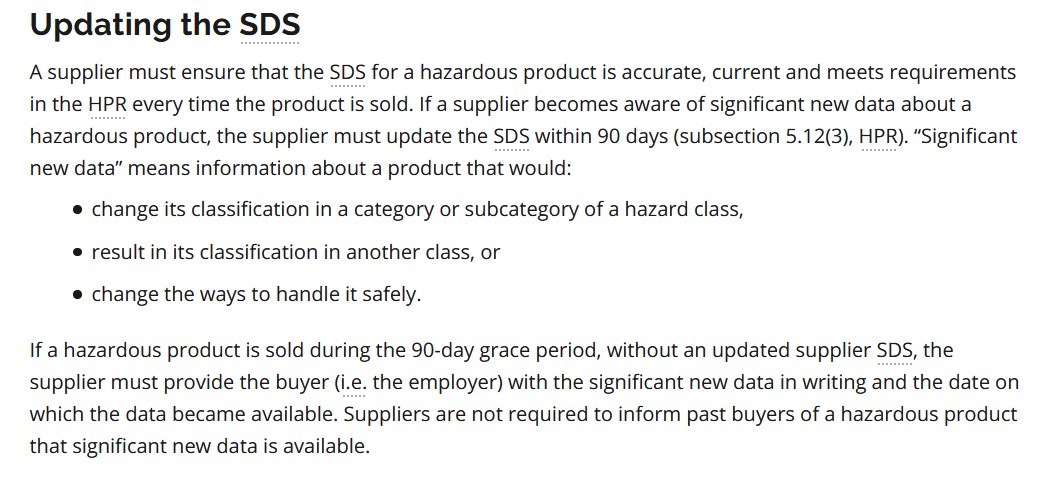Safety Data Sheet (SDS) Requirements in Ontario, Canada. Are You Required to Update Your SDS?
By: Kirsten Alcock, Manager of Product Safety, email
This is a question we hear quite often from our Ontario clients – Is there an SDS expiry date? Do I need to update my SDS if it’s older than three years? Under the older Controlled Products Regulations (CPR), a SDS was REQUIRED to be updated every 3 years regardless if any changes were required. The SDS date needed to be within 3 years. What are we as Ontarians expected to do now? There is misleading information out there about what one should do with their SDSs, so let’s shed some light on this topic in my home Province.
When the Globally Harmonized System (GHS) regulations came into effect in Canada, the three-year renewal period was abolished FEDERALLY. As I have discussed in previous blogs, the three-year effect remains in effect in some provinces which means that you do need to update your SDS if you are selling to these provinces. Ontario however was not one of the provinces that have advised at this time that they want an SDS updated every three years. Does this mean that you don’t look any further? The answer is NO.
The Hazardous Products Regulations (HPR) states in section 5.12 (1) the definition of significant new data. Significant new data is that which changes the hazard classification of the product as a whole. If significant new data comes about for an ingredient within your product or for the product as a whole, there is a requirement to update your SDS. The sale of a hazardous product for which new significant data becomes available MUST be updated within 90 days. You will be in violation of the law if you do not update your SDS. But how do you know if new data exists without looking into each individual component within your product? How do you know your SDS is still compliant if YOU did not author it yourself and you don’t own an authoring system to help you determine this? Is there a new UN number you should be using for shipping that did not exist three years ago? Are there any new Occupational Exposure Limits available that should be provided on your SDS?
When looking into the Ontario regulations, they state this as well. As per the information available online, this is what the Province of Ontario has to say regarding updating your SDS: WHMIS and the Supplier.
If you are not the individual authoring your SDSs, this is difficult to determine. It is not something that you can do quickly. New data is constantly becoming available that has the potential to impact your overall classification. At Dell Tech we pride ourselves on keeping the information on our raw materials up-to-date. New information that can impact a classification can include, but is not be limited to, new toxicity LD50/LC50 data which can have a significant impact on your overall classification. Without doing a recalculation of the product toxicity, your product may not have the correct toxicity class for GHS. New information can also include irritation studies. Perhaps there is new information indicating that a particular chemical is no longer considered irritating to the eyes, skin, or respiratory tract. When there was the switch from the old CPR to the new HPR, there were many instances where a product went from hazardous to non-hazardous based on the new criteria. Some companies may have assumed that a product that was an irritant in the past was an irritant with the new regulations and this is simply not the case.
Where are you getting this data? Are you depending solely on the authoring software? Most software systems are not updated consistently and this puts you at risk of non-compliance. New information is constantly becoming available from data sources such as the European Chemicals Agency (ECHA). Health Canada provided some classification information through their Hazardous Substance Assessments (HSA). Were you aware of this list? Many chemicals are on specific lists that can impact your classification such as those of the International Agency for Research on Cancer (IARC) and the American Conference of Governmental Industrial Hygienists (ACGIH). Is a chemical now considered carcinogenic but was not in the past? These lists change and if a product is now considered a carcinogen, your SDS and label must reflect this change.
Without delving into your product formulation, there is no way for you to know if a classification change is required. You could be putting your company at risk with Health Canada if you are not reviewing your formulations consistently thereby you would be in VIOLATION of the law. At Dell Tech, we continue to advise our clients when their SDS is three years old to help with your compliance requirements. We also update you throughout the three year period if there is a significant change in classification for specific chemicals such as when the Hazardous Substance Assessments were issued. Ultimately, however, you are responsible for the Safety Data Sheet you are providing your clients.
If you would like further information on your safety data sheet requirements or are interested in updating your existing documents to be in compliance with the HPR, please contact us. We’d be happy to help you with the process.
Contact:
Dell Tech
Kirsten Alcock, B.Sc. (Hons)
Manager, Product Safety Group
519-858-5074
kirsten@delltech.com
Dell Tech has provided professional, confidential consulting services to the chemical specialty
industry in Canada, the USA, Europe, and Asia for the last 40 years.
Contact us today for more information.






